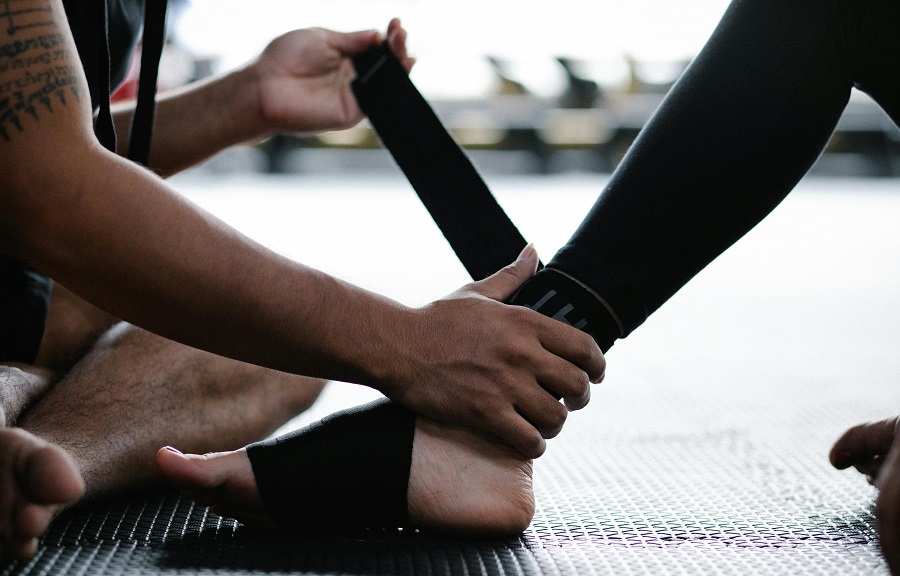Have you recently experienced a foot injury? Maybe you tripped on a walk or pulled a muscle at the gym. Whatever the reasons, wrapping your foot may help to manage your pain and improve your recovery, as it offers your feet and ankles the extra support they need. But how should you go about it?
In this article, we’ll detail the steps you should follow to wrap your feet correctly. Likewise, we’ll help you identify which method may be right for you and when you may need to seek professional help.
For personalised advice, contact our team at CBR Podiatry today.

Heel and sole pain
Pain at the bottom of your foot may be due to several different causes. For example, plantar fasciitis often causes stabbing pain along the sole of your foot due to inflammation of the tendon. Meanwhile, heel spurs– calcium buildup due to overuse– may cause similar stabbing pain in the same area.
Other types of sprain injuries are also fairly common. If you are experiencing heel or sole pain, this wrapping method may help.
How to wrap for sole pain
When strapping for heel or sole pain, sitting will typically help you reach the right areas. Lift your foot and hold it across your lap so that you can see the bottom of your foot.
Once in position, apply two layers of tape horizontally across the ball of your foot. This should reach from your big toe to your pinky toe and should be applied while your toes are stretching outwards.
Next, apply a single length of tape horizontally across the bottom of your foot. This should start at the bottom of your toes and reach across the entirety of your foot and up the back of your leg, over the Achilles tendon.
While applying this piece, ensure your toes and leg are not stretched out.
Top of foot pain
Top-of-foot pain may occur for a variety of reasons but is usually less common than heel and sole pain. Tight or ill-fitting shoes may restrict your feet and cause pain along the top. This often makes it more likely for you to experience injuries and need treatment.
Likewise, Extensor tendonitis is when the tendons along the top of your foot are overused and strained. This is an injury that requires rest and support.
Wrapping for the top of your foot
Wrapping your foot for this type of pain is fairly straightforward. First, you should position your foot with your toes facing down and your heel up. Consider resting it against a step to get the right position but try to avoid stretching.
Keeping your ankle straight, you should apply a piece of strapping tape to the top of your foot, from your toes towards your ankle. Once complete, you’ll want to bend your ankle to test the strapping. If it wrinkles or moves, you’ll want to apply more tape horizontally.
Wrapping a twisted ankle
Twisted ankles are a fairly common occurrence, so ensuring you can wrap your foot correctly to provide support is important to help it recover. To stop your ankles from rolling inwards, first, apply a piece of tape around your calf.
Then, take a length of tape and press the edge onto the tape you’ve already applied. Start from the inside of your leg. Pull the tape down and around the bottom of your heel and back up the other side. The end of the tape should meet the other side of your calf tape. Do this step two or three times and ensure the tape is slightly overlapping each time.
Next, you’ll apply another piece of tape, starting from the same position and following the same path. However, once you reach the ankle on the opposing side you’ll move the tape to cross over the front of the leg.
Apply another few layers of this to ensure your ankle is correctly supported. If your ankles tend to twist either way, rather than just inwards, you may wish to apply this final step from the other direction as well.
Using tape the right way
You can leave your strapping tape on for up to several days before your foot needs to be rewrapped. However, it’s important to pay attention to how your skin reacts to the tape you are using. Some people have been known to experience allergic reactions to tape, which may cause pain, swelling and discomfort. If you experience symptoms like these, ensure you remove the tape and seek medical care if necessary.
When to seek support
As with any injury, going without the right care has the potential to cause more harm. If you have not identified the cause of your foot pain or the type of injury you have, you may apply the wrong technique. This may put pressure on the wrong parts of your foot and cause more pain, slow down your recovery, or even cause long-term issues.
The best way to potentially avoid this is to seek professional help. A podiatrist has in-depth knowledge of how your lower limbs function. They should carefully assess your concerns and identify the cause. With this, they may then tailor the right treatment to ensure your recovery.
We’ll support your feet the right way
Whether you’ve recently experienced an injury or have noticed your foot is causing you pain, reach out to our team. At CBR Podiatry, we offer lengthy, tailored treatments to ensure you are getting the right care no matter your concern. We can even show you how to strap your feet to ensure you are supported and speed up your recovery. To get started, book your appointment today.





